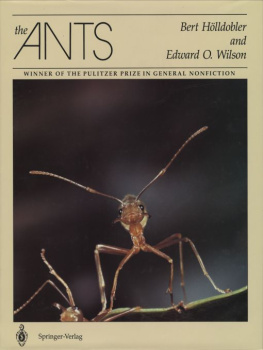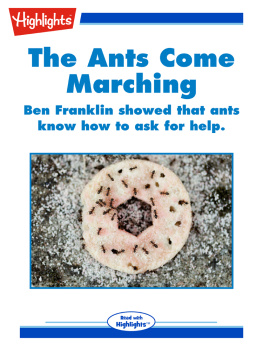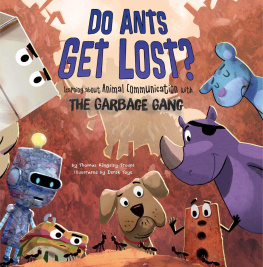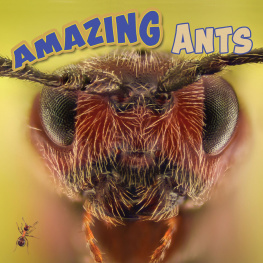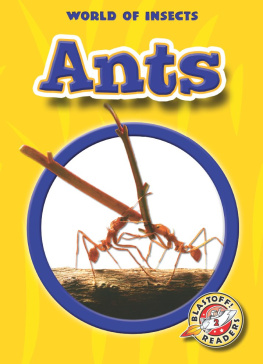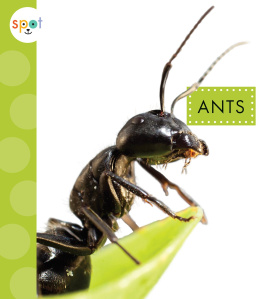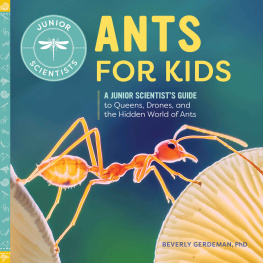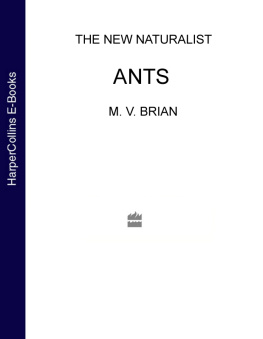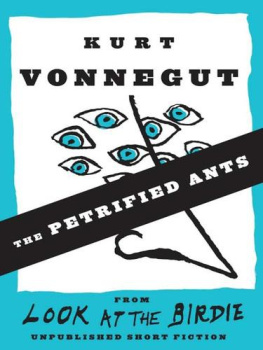Table of Contents
Copyright 1990 by Bert Hlldobler and Edward O. Wilson
All rights reserved
Printed in the United States of America 109876543
Distribution rights for the United States, Canada, the Philippines, Japan, China, Israel, and Egypt:
Harvard University Press
For all other countries:
Springer-Verlag Berlin Heidelberg London Paris Tokyo Hong Kong
ISBN 3-540-52092-9 Springer-Verlag Berlin Heidelberg
This book is printed on acid-free paper, and its binding materials have been chosen for strength and durability.
Designed by Marianne Perlak in Linotron Palatino.
Unless otherwise indicated, all artwork is by the authors.
For the next generation of myrmecologists
CHAPTER 1
The Importance of Ants
Ants are everywhere, but only occasionally noticed. They run much of the terrestrial world as the premier soil turners, channelers of energy, dominatrices of the insect faunayet receive only passing mention in textbooks on ecology. They employ the most complex forms of chemical communication of any animals and their social organization provides an illuminating contrast to that of human beings, but not one biologist in a hundred can describe the life cycle of any species. The neglect of ants in science and natural history is a shortcoming that should be remedied, for they represent the culmination of insect evolution, in the same sense that human beings represent the summit of vertebrate evolution.
During the second half of the Paleozoic Era a sequence of three events occurred that predetermined the character of the modern insect fauna and set the stage for the origin of ants (F. M. Carpenter, 1989). The first was the invention of flight, never before achieved by any group of organisms in the history of life. One insect line out of the many existing in the Paleozoic somehow evolved wings in the adult stage, and it soon afterward enjoyed extensive species formation and diversification. Then a single line within this expanding paleopterous group attained the ability to fold the wings back over the body when not in use, giving the adults greater mobility on the ground after alighting. From this neopterous group, which also prospered, came still another line that attained complete metamorphosis. Now highly specialized larvae occupying one ecological niche could be transfigured into radically different adult forms occupying another ecological niche. This third, holometabolous group of insects exceeded its predecessors in evolutionary attainment. It radiated extensively to produce the most diverse and abundant insect orders now in existence, namely the beetles (Coleoptera), the flies (Diptera), and the bees, wasps, and their relatives (Hymenoptera).
The story did not quite end at this point. During Cretaceous times, spanning 140 million to 65 million years before the present, a fourth and wholly different kind of event occurred, the origin of advanced social life. All of the insects in the fourth category, comprising the termites, the ants, and some of the bees and wasps, are colonial. More precisely, they are eusocial in their habits. This means that two or more generations overlap in the society, adults take care of the young, and, most importantly, adults are divided into reproductive and nonreproductive castes, in other words queens and kings versus workers (Michener, 1969, 1974; Wilson, 1971).
To a degree seldom grasped even by entomologists, the modern insect fauna has become predominantly social. Recent measurements suggest that about one-third of the entire animal biomass of the Amazonian terra firme rain forest is composed of ants and termites, with each hectare of soil containing in excess of 8 million ants and 1 million termites. These two kinds of insects, along with bees and wasps, make up somewhat more than 75 percent of the total insect biomass (Beck, 1971; Fittkau and Klinge, 1973). Ants and termites similarly dominate the forests and savannas of Zaire (Dejean et al., 1986). Although comparable biomass measurements have not yet been made elsewhere, it is our subjective impression that the eusocial insects, ants foremost among them, are comparably abundant in most other principal habitats around the world.
For example, on the Ivory Coast savanna the density of ants is 7,000 colonies and 20 million individuals per hectare, with one species alone, Camponotus acvapimensis, accounting for 2 million of the individuals (Lvieux, 1966, 1982). Such African habitats are often visited by driver ants (Dorylus spp.), single colonies of which occasionally contain more than 20 million workers (Raignier and van Boven, 1955). And the driver ant case is far from the ultimate. A supercolony of the ant Formica yessensis on the Ishikari Coast of Hokkaido was reported to be composed of 306 million workers and 1,080,000 queens living in 45,000 interconnected nests across a territory of 2.7 square kilometers (Higashi and Yamauchi, 1979).
The local diversity of ants is substantial, far exceeding that of other social insects and reflecting the manner in which ant species have evolved to saturate a wide range of feeding niches in the soil and vegetation. In lowland rain forest at the Busu River, northeastern Papua New Guinea, Wilson (1959c) collected 172 species of ants belonging to 59 genera in an area of about 1 square mile (2.6 km2). Barry Bolton (in Room, 1971) recorded 219 species in 63 genera in a square mile of cocoa plantation and forest at Tafo, Ghana, while Kempf (1964a and personal communication) found 272 species belonging to 71 genera in a comparable area at Agudos, So Paulo State, Brazil. During two years of fieldwork, Manfred Verhaagh (personal communication) collected at least 350 species belonging to 71 genera at the Rio Yuyapichis, in the larger valley of the Rio Pachitea, Peru; the western Amazon Basin, in which this watershed is located, may have the richest ant fauna in the world. Moving to more limited sample spaces, Room (1971) recorded 48 genera and 128 species from only 250 square meters in a cocoa farm in Ghana. Wilson (1987c) identified 43 species in 26 genera in a single tree in the Tambopata Reserve in the Peruvian Amazon. If the terrestrial fauna had been assayed around the tree as well, the total point diversity would probably have rivaled that of Rooms Ghanaian sample. Temperate faunas are less rich but often impressive nonetheless: 23 genera and 87 species in 5.6 square kilometers at the E. S. George Reserve in Michigan (Talbot, 1975), and 30 genera and 76 species in 8 square kilometers of the Welaka Reserve, Florida (Van Pelt, 1956).
The impact of ants on the terrestrial environment is correspondingly great. In most terrestrial habitats they are among the leading predators of other insects and small invertebrates (Wilson, 1971; Jeanne, 1979; Lvieux, 1982; Srensen and Schmidt, 1987). Leafcutter ants, in other words members of the genera Acromyrmex and Atta, are species for species the principal herbivores and the most destructive insect pests of Central and South America (Weber, 1972; Cherrett, 1982). Pogonomyrmex and other harvester ants rank among the principal granivores, competing effectively with mammals for seeds in deserts of the southwestern United States (Davidson et al., 1980). In another adaptive zone, ants are sufficiently dense to reduce the abundance of ground-dwelling spiders and carabid beetles, especially when these arthropods are specialized to live in the soil and rotting vegetation (Darlington, 1971; Cherix, 1980; Wilson, 1987b). Where montane habitats are high enough to be mostly free of ants, such as the summit of Mt. Mitchell in North Carolina and the Sarawaget Mountains of Papua New Guinea above 2,500 meters, carabids and spiders increase markedly in numbers.


